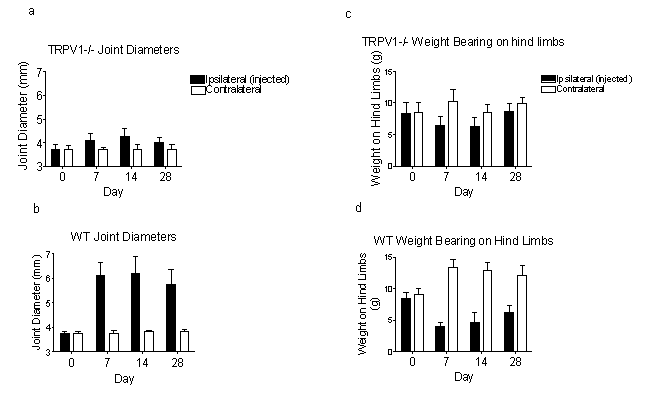| pA2 online © Copyright 2004 The British Pharmacological Society |
047P
University of Newcastle Winter Meeting December 2004 |
Mice lacking the TRPV1 receptor develop milder joint inflammation following FCA Barton, N.J.1, McQueen,D.S.1, Gauldie,S.D.1, Wilson,A.W.2, Clayton,N.M.2, Chessel,I.P. 2. 1Division of Neuroscience, University of Edinburgh. 1George Sq, EH8 9JZ, UK, 2Neurology CEDD, GlaxoSmithKline R&D Ltd, Harlow, Essex CM19 5AW, UK. |
|
The TRPV1 receptor (TRPV1R) is a non-selective ligand-gated cation channel expressed predominantly by nociceptive sensory neurons (Caterina et al., 1997) . The aim of this study was to determine the role of this receptor in the development and maintenance of joint inflammation evoked by Freunds Complete Adjuvant (FCA) in a murine model of chronic unilateral arthritis. The body weights, joint diameters and weight distribution on hind limbs (Clayton et al., 1997) were measured in male C57BL6 wild type (WT) and TRPV1R-/- mice (Davis et al. 2000). Five C57BL6 WT and 10 TRPV1R-/- mice were injected with FCA (200µg/20µl intra articular) in the left stifle joint under 3% halothane anaesthesia, as described by Gauldie et al. (2004). Four C57BL6 WT and 10 TRPV1R-/- mice were injected with vehicle (20 µl heavy liquid paraffin). Measurements were made three times per week for 30d. Intra-articular FCA caused an increase in ipsilateral joint diameter in WT mice that was significantly greater than that observed in TRPV1R-/- mice (P<0.01; MannWhitney U), see Figure 1. Weight bearing on the hind limbs shifted from equal weight distribution on both joints towards the untreated joint after FCA injection. The difference between the two joints was statistically significant in both groups (P<0.05; Mann Whitney U). There were no significant differences between the strains (P>0.05; Mann Whitney U; Fig.1).

Figure 1. Ipsilateral (injected with FCA) and contralateral knee diameters of male (a) TRPV1-/-mice and (b) WT mice. Weight bearing of male (c) TRPV1-/- mice and (d) WT mice.
Our results indicate that TRPV1Rs play a key role in the development of inflammation, in agreement with Keeble et al. (2004). In addition, data from weight distribution on hind limbs suggest that the TRPV1Rs play a role in hyperalgesia following i.art FCA, however the difference from WT was not statistically significant, probably due to the variability of the data. In conclusion our data suggests TRPV1R is involved in joint inflammation and hyperalgesia. However, since neither were completely attenuated in the knock out mice, it is probable that multiple mediators, receptors and mechanisms are involved in the development and maintenance of inflammatory joint disease.
Caterina, M.J. et al.(1997). Nature,389,816-24.
Clayton, N.M. et al. (1997) Br J Pharmacol 120, 75P.
Davis, J.B. et al. (2000). Nature, 405, 183-187.
Gauldie S.D. et al. (2004). J Neurosci Methods, 139, 281-291.
Keeble, J.E. et al. (2004). Proc British Pharm Soc,pA2 online, 21, 43P.